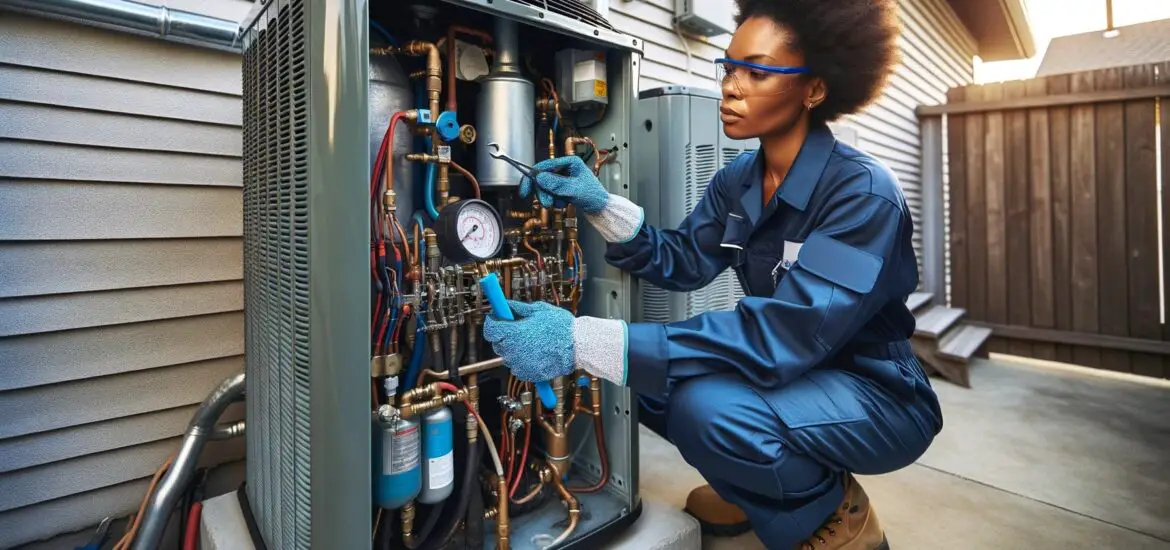This comprehensive guide will provide you with detailed steps to identify, diagnose, and perform a Freon overcharge fix on your air conditioning system.

Table of Contents
Assessing the Impact of Freon Overcharge
Understanding the full impact of a Freon overcharge on your AC system is crucial. An overcharged system strains the compressor, leading to potential damage and reduced lifespan. This strain also leads to inefficiency, as the system must work harder, increasing energy costs.
Overcharge can also result in inadequate cooling and frequent cycling of the unit. These issues not only cause discomfort but can also lead to increased wear and tear on other components of the AC system. Assess the immediate need for a fix based on these factors and the overall performance degradation of your unit.
Steps to Perform a Freon Overcharge Fix
Follow the steps below to learn how to perform a Freon overcharge fix on your AC system.
Identifying Freon Overcharge
Identifying a Freon overcharge in your AC system involves several critical steps. First, recognize the signs: reduced cooling efficiency, a hot compressor, strange noises, and high-pressure readings.
To confirm overcharge, use a refrigerant manifold gauge set like this BENTISM AC Manifold Gauge Set 3-Way Fit. Ensure your AC is off and the compressor is not running to get an accurate static pressure reading. Attach the gauges to the low and high-pressure service ports on your outdoor unit.
The pressure readings should match your AC unit’s specifications, which can be found in the user manual. If the pressure is significantly higher than recommended, it indicates an overcharge. It’s essential to perform this test in ambient outdoor temperatures. This is because extreme cold or heat can affect the readings.
Safely Removing Excess Freon
When removing excess Freon, safety and legality are paramount. Always power off the AC system before starting. Using a certified refrigerant recovery machine is the only legal method for removing Freon.
Connect the machine to the service valve on your compressor. The machine will safely extract the excess refrigerant into a recovery cylinder. It’s critical to avoid any refrigerant leaks during this process, as they can harm the environment and are illegal.
Always wear safety gear, including gloves and goggles, to protect yourself from potential exposure to the refrigerant.
You can get this BENTISM Portable 1 HP Refrigerant Recovery Machine from Walmart.
Checking and Recharging the System
After extracting the excess Freon, recheck the system’s pressure using your gauge set. If the pressure is now within the recommended range, no further action is needed.
However, if the system is undercharged (pressure too low), carefully recharge it. Attach a refrigerant can to the service valve and slowly add refrigerant, monitoring the pressure closely.
It’s advisable to add small amounts, and then wait and observe the system’s response before adding more. This cautious approach prevents accidental overcharging.
After recharging, run the AC for several minutes and recheck the pressure and cooling performance to ensure everything is operating as it should.
Preventing Future Overcharges
Preventing future Freon overcharges involves regular maintenance and understanding your AC system. Schedule regular professional maintenance checks, especially before the cooling season begins.
Educate yourself on the normal operating pressures for your specific AC model and monitor these periodically. If you notice pressure deviations, investigate promptly.
In addition, always ensure that any refrigerant handling is done by certified professionals. Keeping a detailed maintenance log can help track your AC system’s performance over time. This will aid in early detection of potential issues.